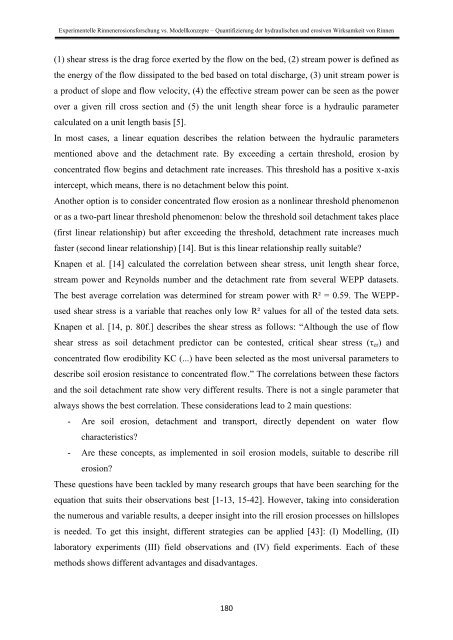Stefan Wirtz Vom Fachbereich VI (Geographie/Geowissenschaften ...
Stefan Wirtz Vom Fachbereich VI (Geographie/Geowissenschaften ...
Stefan Wirtz Vom Fachbereich VI (Geographie/Geowissenschaften ...
Create successful ePaper yourself
Turn your PDF publications into a flip-book with our unique Google optimized e-Paper software.
Experimentelle Rinnenerosionsforschung vs. Modellkonzepte – Quantifizierung der hydraulischen und erosiven Wirksamkeit von Rinnen<br />
(1) shear stress is the drag force exerted by the flow on the bed, (2) stream power is defined as<br />
the energy of the flow dissipated to the bed based on total discharge, (3) unit stream power is<br />
a product of slope and flow velocity, (4) the effective stream power can be seen as the power<br />
over a given rill cross section and (5) the unit length shear force is a hydraulic parameter<br />
calculated on a unit length basis [5].<br />
In most cases, a linear equation describes the relation between the hydraulic parameters<br />
mentioned above and the detachment rate. By exceeding a certain threshold, erosion by<br />
concentrated flow begins and detachment rate increases. This threshold has a positive x-axis<br />
intercept, which means, there is no detachment below this point.<br />
Another option is to consider concentrated flow erosion as a nonlinear threshold phenomenon<br />
or as a two-part linear threshold phenomenon: below the threshold soil detachment takes place<br />
(first linear relationship) but after exceeding the threshold, detachment rate increases much<br />
faster (second linear relationship) [14]. But is this linear relationship really suitable?<br />
Knapen et al. [14] calculated the correlation between shear stress, unit length shear force,<br />
stream power and Reynolds number and the detachment rate from several WEPP datasets.<br />
The best average correlation was determined for stream power with R² = 0.59. The WEPPused<br />
shear stress is a variable that reaches only low R² values for all of the tested data sets.<br />
Knapen et al. [14, p. 80f.] describes the shear stress as follows: “Although the use of flow<br />
shear stress as soil detachment predictor can be contested, critical shear stress (τ cr ) and<br />
concentrated flow erodibility KC (...) have been selected as the most universal parameters to<br />
describe soil erosion resistance to concentrated flow.” The correlations between these factors<br />
and the soil detachment rate show very different results. There is not a single parameter that<br />
always shows the best correlation. These considerations lead to 2 main questions:<br />
- Are soil erosion, detachment and transport, directly dependent on water flow<br />
characteristics?<br />
- Are these concepts, as implemented in soil erosion models, suitable to describe rill<br />
erosion?<br />
These questions have been tackled by many research groups that have been searching for the<br />
equation that suits their observations best [1-13, 15-42]. However, taking into consideration<br />
the numerous and variable results, a deeper insight into the rill erosion processes on hillslopes<br />
is needed. To get this insight, different strategies can be applied [43]: (I) Modelling, (II)<br />
laboratory experiments (III) field observations and (IV) field experiments. Each of these<br />
methods shows different advantages and disadvantages.<br />
180
















